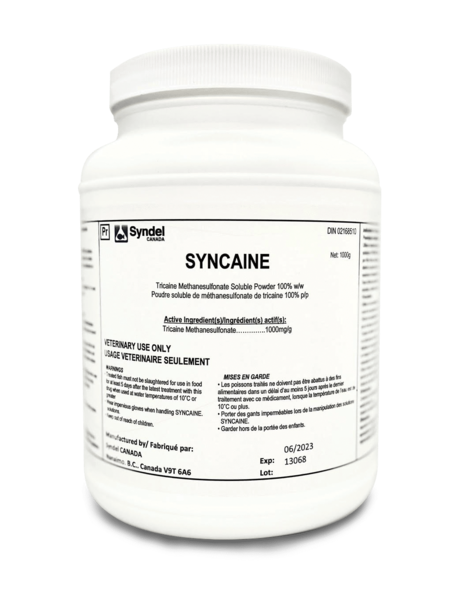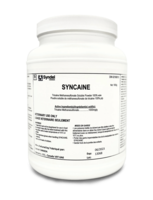Syncaine (FormerlyTricaine-S and MS 222) 10g and 100g ships 2nd Day Air!
Starts at: $73.00
Brand: Syndel USA (formerly Western Chemical)
SKU:Syncaine
FDA Approved Fish Anesthetic!
DESCRIPTION
Syndel’s Syncaine® (also known as MS-222, TMS, tricaine methanesulfonate) is a fish anesthetic used for the temporary immobilization of fish, amphibians, and other aquatic cold-blooded animals (poikilotherms) around the world. Syncaine® has long been recognized as a valuable tool for the proper handling of these animals during manual spawning (fish stripping), weighing, measuring, marking, surgical operations, transport, photography, and research. Syncaine® is a fully approved drug in the USA, Canada and the United Kingdom.
Please review all safety and handling information before using this product.
Syndel is the world’s largest manufacturer of Syncaine® fish anesthetic. It is made in our FDA inspected Ferndale, Washington USA manufacturing plant according to Good Manufacturing Practices (GMP) to ensure the purity, strength, and quality of the product.
If anesthetizing fish for transport or handling try out Vidalife, if sedating for spawning try one of our many spawning aids.
Available Sizes: 10g, 100g, 1kg Bottle
For more information on fish anesthetics, please see our FAQ page.
SYNCAINE® SAFETY AND HANDLING
Do not overexpose fish to lethal levels of Syncaine®.
Since, in many cases, relatively rapid rates of anesthesia can be achieved only by exceeding the lethal concentration of Syncaine®, it is necessary to return anesthetized fish to fresh water before they are overexposed. Additional exposure following medullary collapse may result in mortality. Use in fish intended for food should be restricted to Ictaluridae, Salmonidae, Esocidae, and Percidae, and water temperature exceeding 10°C (50°F). In other fish and in cold-blooded animals, Syncaine® should be limited to hatchery or laboratory use.
Store at room temperature in a well-ventilated, secure area with the lid tightly closed. Wear all appropriate PPE when handling this product. If exposed, flush with clean water and consult a medical professional.
When preparing an anesthetic bath, do not use distilled or deionized water, or water containing chlorine, heavy metals, or other toxic contaminants.
Always test planned dosage prior to large-scale use. Review “Syncaine® Directions for Use” in the Resources section for levels of fish anesthesia and appropriate handling techniques. Dispose of product and solutions in accordance with applicable regulations.
In the USA, food fish treated with Syncaine® must undergo a 21-day withdrawal period before slaughter for human consumption. In Canada, use of Syncaine® must be followed by a five-day withdrawal period for fish held at temperatures of 10o C or greater.
Consult your veterinarian or fish health professional for more information about Syncaine®.
Informational links from manufacturer:
Syncaine® Concentration Calculator Based on Species and Anesthesia Type
Syncaine® Package Insert – Canada
Syncaine® Package Insert – USA
Guide to Using Drugs, Biologics, and Chemicals in Aquaculture
How Much Syncaine® Should I Use for Fish Anesthetization?
ALL SALES FINAL
Features
- FDA approved fish anesthetic
- Used for handling during spawning, weighing, measuring transport, photography, research and more
- Fine crystalline powder fish anesthetic that is mixed with water prior to use
- Safe and effective
- Tricaine-S is the primary MS-222 being used today
- Packaged in FDA approved plastic containers
The effects of stress on fish during handling for vaccination, tagging, weight sampling and spawning are important considerations in health and production management. Stress on the fish should be minimized so that they can properly recover from the procedure or respond to the vaccine and return to normal feeding and growth as soon as possible. Fish anesthetics play a large role in reducing stress during any handling.
WHICH FISH ANESTHETICS ARE APPROVED IN MY COUNTRY?
Canada
Anesthetics for fish are prescription drugs in Canada. There are currently only two legal approved fish anesthetics in Canada: Aqualife TMS and Aquacalm™.
Aqualife TMS is approved for use in salmonids and is available by prescription from your veterinarian. When used there is a 50 day withdrawal period.
Aquacalm (Metomidate hydrochloride) is approved for use in non-food fish species.
Veterinarians may prescribe Aquacalm for use with food fish with an “off-label” prescription. You must always consult with a veterinarian before using any prescription drug.
USA
Tricaine-S (MS-222) is an FDA approved fish anesthetic used for the temporary immobilization of fish, amphibians, and other aquatic cold-blooded animals (poikilotherms). When used there is a 21 day withdrawal period.
Aquacalm™ has been granted Indexed status by the FDA for the sedation and anesthesia of ornamental finfish. Aquacalm™ is not for use in fish intended for human or animal consumption.
All Other Countries
Tricaine is available in a number of other countries. Please contact Syndel for details.
As anesthetics typically fall under the drug legislation in various countries, only approved products should be used. Over the years, many other chemicals have been used as fish anesthetics. These include 2-phenoxyethanol, carbon dioxide, quinaldine, methyl-pentynol, etc. None of these are approved and should not be used with your fish.
The choice of anesthetic and dose is dependent upon many factors including the effect desired, the size and condition of the fish, and the ultimate purpose of the fish. Withdrawal time of the fish anesthetic is of major importance if the fish are for human consumption and this varies depending upon the product, the fish and the water temperature. If the drug is used other than under the approved label directions, the withdrawal time is at the discretion of the veterinarian. The mode of action also affects the choice of anesthetic.
Tricaine-S/ Aqualife TMS acts upon the peripheral nervous system, “freezing” the fish while Aquacalm acts upon the central nervous system causing the fish to be “hypnotized” or “sleepy” while still able to react.
Choosing your anesthetic and dose should be done in consultation with your fish health expert and your veterinarian.
Note: This discussion relates only to Tricaine-S/ Aqualife TMS and Aquacalm.
After choosing the anesthetic and dose, an appropriate amount of the anesthetic should be dissolved in a small amount of water, and then evenly dispersed throughout the anesthesia bath and well mixed. The fish should be fasted for 24 hours before being anesthetized to reduce contamination of the anesthetic bath.
Anesthetic totes should be plastic or fiberglass. Metal containers must not be used: they react with tricaine to produce harmful byproducts. As there is often variability in effect, always test a few fish before proceeding with mass anesthesia. This variability can result from water quality, fish size, temperature, pH, hardness, species and even the strain of fish.
Aquacalm is more stable in solution than Tricaine-S/ Aqualife TMS. It is always a good idea to conduct anesthesia in the shade away from UV and direct sunlight as these conditions may cause Tricaine-S/Aqualife TMS solution to become toxic.
The anesthetic baths should be oxygenated and replaced as they become contaminated or every 2 to 4 hours.
It is not a good idea to overload anesthetic baths with fish because you do not want to prolong anesthesia time.
The ideal situation is to reach anesthesia within 3 to 4 minutes and recovery in 3 to 4 minutes.
The usual dose for TRICAINE-S in the USA is 50 to 80 ppm.
The usual dose for Aquacalm in the USA is 5 to 10 ppm for anesthesia and 0.1 to 0.5 ppm for sedation, while 0.25-1.0 in Canada. Aquacalm can also be used to sedate the fish prior to anesthesia with Tricaine-S/Aqualife TMS. If this is done, the Tricaine-S/ Aqualife TMS dose needs to be reduced.
DOES FISH ANESTHETIC AFFECT WATER QUALITY?Tricaine-S/ Aqualife TMS decreases the pH of the anesthetic bath, especially in soft freshwater. The amount of the change depends on the water that is used; some water can buffer against pH changes, other water will show large pH changes with Tricaine -S/ Aqualife TMS. Anesthetic baths can be buffered with sodium bicarbonate to maintain a steady pH. Each water source has unique characteristics, so the amount of sodium bicarbonate to be added must be determined by measuring the pH.
Sodium bicarbonate can be added to the anesthetic bath as a powder or as a stock solution. As a starting rule-of-thumb, adding twice as much sodium bicarbonate as Tricaine-S/ Aqualife TMS should bring most anesthetic solutions back to near normal pH. Measure the pH of the Tricaine-S/ Aqualife TMS solution, add sodium bicarbonate solution and measure the pH again. If the pH is still lower than the rearing tank pH, add more sodium bicarbonate. Once the amount of sodium bicarbonate needed has been established, the same amount can be added each time the anesthetic bath is changed. Check to confirm that the bath is at the right pH. Never mix the sodium bicarbonate with Tricaine-S/ Aqualife TMS before adding to the anesthetic bath. Add the Tricaine-S/ Aqualife TMS first, then add the sodium bicarbonate separately, do not pre-mix.

It is important that the recovery of the fish is monitored, and problems corrected. The fish should be returned to high quality conditions and feed as soon as possible.
Before you start, test the anesthetic on a small sub sample of fish. The anesthetic dose should be adjusted so that the fish are anesthetized quickly and are moved along smoothly to the handling or vaccination station. If large numbers of fish are placed in the anesthetic, water quality suffers, monitoring the fish for depth of anesthetic is more difficult and the flow of fish to the handlers is not smooth. The accompanying table of doses, induction and recovery times shows the effects of increasing the anesthetic dose.

Tricaine-S/Aqualife TMS
With each batch of fish, Tricaine-S/ Aqualife TMS levels in the anesthetic bath are reduced. Lower doses of Tricaine-S/ Aqualife TMS in over used baths mean longer times before the fish are anesthetized, resulting in increased stress and prolonged procedure times. Long periods of exposure to UV rays from sunlight can also reduce Tricaine-S/ Aqualife TMS levels
Customer Question:
"What do you know about the efficacy of the drug after its expiration date ?
Manufacturer Answer:
We cannot recommend use of expired product, nor do we keep efficacy information past the expiration date.
View the PDF for complete operating instructions.



